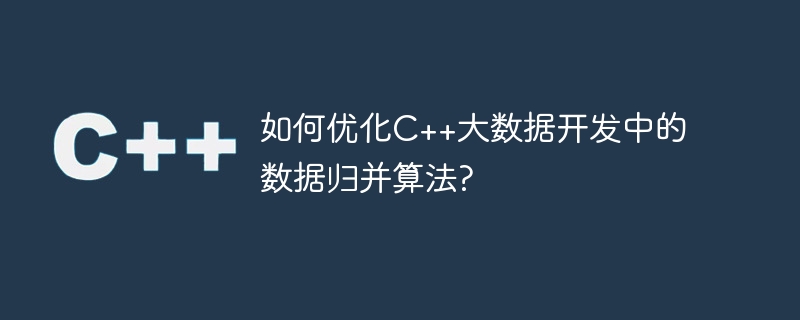

How to optimize the data merging algorithm in C big data development?
Introduction:
Data merging is a problem often encountered in big data development. Especially when working with two or more sorted data collections. In C, we can implement the data merging algorithm by using the idea of merge sort. However, when the amount of data is large, the merging algorithm may face efficiency issues. In this article, we will introduce how to optimize the data merging algorithm in C big data development to improve operating efficiency.
1. Implementation of ordinary data merging algorithm
Let’s first take a look at how the ordinary data merging algorithm is implemented. Suppose there are two sorted arrays A and B, and we want to merge them into a sorted array C.
#include<iostream>
#include<vector>
using namespace std;
vector<int> merge_arrays(vector<int>& A, vector<int>& B) {
int i = 0, j = 0;
int m = A.size(), n = B.size();
vector<int> C;
while (i < m && j < n) {
if (A[i] <= B[j]) {
C.push_back(A[i]);
i++;
} else {
C.push_back(B[j]);
j++;
}
}
while (i < m) {
C.push_back(A[i]);
i++;
}
while (j < n) {
C.push_back(B[j]);
j++;
}
return C;
}In the above code, we use two pointers i and j to point to the elements in two sorted arrays A and B respectively, compare the sizes of the two elements and put the smaller one into the result array C middle. When one of the arrays is traversed, we put the remaining elements of the other array into C one by one.
2. Optimization Algorithm 1: Reduce Memory Usage
When processing large data collections, memory usage is an important issue. In order to reduce memory usage, we can use an iterator instead of creating a new array C. The specific implementation code is as follows:
#include<iostream>
#include<vector>
using namespace std;
void merge_arrays(vector<int>& A, vector<int>& B, vector<int>& C) {
int i = 0, j = 0;
int m = A.size(), n = B.size();
while (i < m && j < n) {
if (A[i] <= B[j]) {
C.push_back(A[i]);
i++;
} else {
C.push_back(B[j]);
j++;
}
}
while (i < m) {
C.push_back(A[i]);
i++;
}
while (j < n) {
C.push_back(B[j]);
j++;
}
}
int main() {
vector<int> A = {1, 3, 5, 7, 9};
vector<int> B = {2, 4, 6, 8, 10};
vector<int> C;
merge_arrays(A, B, C);
for (auto num : C) {
cout << num << " ";
}
cout << endl;
return 0;
}In the above code, we pass the result array C as a parameter into the merge_arrays function, and use an iterator to store the result directly in C, thus avoiding the cost of creating a new array. additional memory usage.
3. Optimization Algorithm 2: Reduce Time Complexity
In addition to reducing memory usage, we can also reduce the time complexity of data merging through optimization algorithms. In the traditional merge algorithm, we need to traverse the entire array A and array B, but in fact, we only need to traverse until the end of one of the array traversals. The specific implementation code is as follows:
#include<iostream>
#include<vector>
using namespace std;
void merge_arrays(vector<int>& A, vector<int>& B, vector<int>& C) {
int i = 0, j = 0;
int m = A.size(), n = B.size();
while (i < m && j < n) {
if (A[i] <= B[j]) {
C.push_back(A[i]);
i++;
} else {
C.push_back(B[j]);
j++;
}
}
while (i < m) {
C.push_back(A[i]);
i++;
}
while (j < n) {
C.push_back(B[j]);
j++;
}
}
int main() {
vector<int> A = {1, 3, 5, 7, 9};
vector<int> B = {2, 4, 6, 8, 10};
vector<int> C;
merge_arrays(A, B, C);
for (auto num : C) {
cout << num << " ";
}
cout << endl;
return 0;
}In the above code, when we traverse arrays A and B, if an array has been traversed, then we can directly append the remaining elements in the other array to The result array C follows without further comparison. This can reduce the number of loops and reduce time complexity.
Conclusion:
By optimizing the data merging algorithm in C big data development, we can significantly improve operating efficiency. By reducing memory usage and time complexity, we can better cope with large-scale data processing needs. In actual development, based on specific scenarios and needs, we can further optimize the algorithm to achieve better results.
The above is the detailed content of How to optimize the data merging algorithm in C++ big data development?. For more information, please follow other related articles on the PHP Chinese website!
 What are the four big data analysis tools?
What are the four big data analysis tools?
 what is optimization
what is optimization
 Page replacement algorithm
Page replacement algorithm
 Baidu keyword optimization software
Baidu keyword optimization software
 Baidu SEO keyword ranking optimization method
Baidu SEO keyword ranking optimization method
 What are the differences between c++ and c language
What are the differences between c++ and c language
 Recommended learning order for c++ and python
Recommended learning order for c++ and python
 Cost-effectiveness analysis of learning python and c++
Cost-effectiveness analysis of learning python and c++




